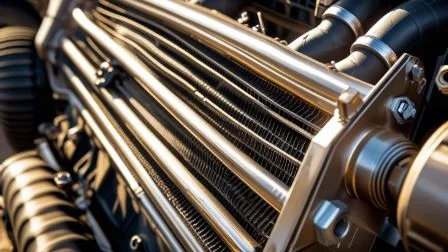How to Choose the Right Radiator for You?
The radiator is crucial for your engine’s health. Choosing the right radiator is not only about finding a part that fits, but also about extending your machine’s longevity and reducing downtime, preventing engine overheating, and costly repairs. This guide aims to provide you with the important knowledge to choose a high-quality radiator that meets your operational needs and budget.
What is a Radiator
The radiator is crucial for your engine’s health. Choosing the right radiator is not only about finding a part that fits, but also about extending your machine’s longevity and reducing downtime, preventing engine overheating, and costly repairs. This guide aims to help you choose a high-quality radiator that meets your needs.
Radiator Types
While all radiators serve the same core function, they are typically of two different types.
Downflow Radiators
In this traditional design, the coolant tanks are located on the top and bottom. Coolant enters the top tank, flows downward through the core tubes by gravity, and exits through the bottom tank. You’ll often find these in older equipment or machines with taller engine bays.
Crossflow Radiators
A more modern design, crossflow radiators have their tanks on the sides. Coolant enters one side, flows horizontally across the core, and exits on the opposite side. This design allows for a lower, wider radiator, making it ideal for the compact engine compartments of many modern machines.
4 Practical Tips for Selecting a Radiator
- Confirm the Part Number: The most reliable way to guarantee a perfect fit is to match the OEM part number from your old radiator.
- Assess Your Working Environment: If you work in dusty or muddy conditions, consider a radiator with a slightly lower fin density to prevent clogging.
- Inspect Upon Arrival: Before installation, carefully inspect your new radiator for any damage that may have occurred during shipping, such as bent fins or cracked tanks.
- Check Hose Connections: Double-check that the inlet and outlet port diameters and locations match your equipment’s hoses.
Key Factors to Consider When Selecting a Radiator
When you’re looking for a radiator, besides price, you can focus on these factors, which are critical for performance and durability:
Material
Radiators are typically made of aluminum or a copper-brass combination. Modern radiators are almost exclusively aluminum because of its lightweight and excellent heat dissipation ability. Copper-brass is suitable for extreme-duty applications for its durability and ease of repair in the field.
Core Size and Thickness
The “core” is the central part of the radiator with the tubes and fins. A larger or thicker core has a greater surface area and coolant capacity, leading to improved cooling efficiency. For heavy equipment running at constant load, a strong core is critical.
Fin Density
This means the number of cooling fins per inch. High fin density provides more surface area for heat exchange, but it can get clogged more easily with dirt, dust, and debris; while a lower fin density may be preferable for equipment used in extremely dirty environments to ensure consistent airflow.
Fitment and Compatibility
This is the most important factor. The radiator must be a direct-fit for your specific machine model to ensure all mounting points and hose connections line up perfectly.
OEM vs. Aftermarket
When you need a replacement, you have two main choices: OEM or aftermarket.
- OEM radiators are made by the same company that built your machine. They guarantee a perfect fit and quality, but they come with a significant price premium.
- Aftermarket radiators come from a third party. The quality can range from poor to excellent. This is where you need to be a smart buyer. High-quality aftermarket suppliers, like FridayParts.com, bridge this gap. Choosing a reputable aftermarket supplier gives you the best of both: quality you can trust and a price that respects your budget.
Conclusion
A radiator impacts your machine’s performance and lifespan directly. Knowing the basics of how they work, what types are available, and what to look for when selecting a radiator, you can make a wise decision. Remember to choose a high-quality radiator, either OEM or aftermarket. Now select a perfect radiator for yourself with this guide!




